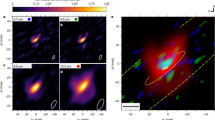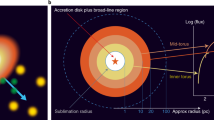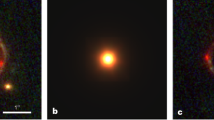Abstract
M82 is the nearest galaxy evidently containing a strong central source of energy, which is possibly similar to the nucleus of a Seyfert galaxy, and this seems to have given rise to an unusual explosive event1. The appearance of M82 is that of a flattened irregular system seen nearly edge-on, and if a distinct nucleus exists, it is highly obscured2 at optical wavelengths. Compact radio features are, however, present, and complex resolved radio and infrared sources and bright visible H II regions occupy an area ∼ 12″×35″ in the centre of the galaxy. The outer parts of the galaxy show linear optical polarisation, discovered by Elvius3. This is thought to arise from reflection in an extensive halo of dust particles of the light of the bright nucleus (or nuclear region) and of the galactic disk (for a recent discussion, see ref. 4). Consequently, observation of the polarisation can give information about the position and luminosity of the energetic nuclear region, and about the scattering medium. Outstanding questions about M82 involve the existence and nature of a compact nucleus and the morphological and evolutionary state of the whole galaxy.
This is a preview of subscription content, access via your institution
Access options
Subscribe to this journal
Receive 51 print issues and online access
$199.00 per year
only $3.90 per issue
Buy this article
- Purchase on Springer Link
- Instant access to full article PDF
Prices may be subject to local taxes which are calculated during checkout
Similar content being viewed by others
References
Burbidge, E. M., Burbidge, G. R., and Rubin, V. C., Astrophys. J., 140, 942 (1964).
Gillett, F. C., Kleinmann, D. E., Wright, E. L., and Capps, R. W., Astrophys. J. Lett., 198, L65 (1975).
Elvius, A., Lowell Obs. Bull., 5, 281 (1963).
Solinger, A. B., and Markert, T., Astrophys. J., 197, 309 (1975).
Öhman, Y., Mon. Not. R. astr. Soc., 99, 624 (1939).
McMullan, D., Powell, J. R., and Curtis, N. A., Adv. Elec. Phys., 33 A, 37 (1972).
Elvius, A., Lowell Obs. Bull, 7, 117 (1969).
Sandage, A., and Visvanathan, N., Astrophys. J., 157, 1065 (1969).
Mathewson, D. S., and Ford, V. L., Mem. R. astr. Soc., 74, 139 (1970).
McCrea, W. H., Tercentary Symposium of the Royal Greenwich Observatory 1975 July, 22–25 (in the press).
Hargrave, P. J., Mon. Not. R. astr. Soc., 168, 491 (1974).
Kleinmann, D. E., and Low, F. J., Astrophys. J. Lett., 161, L203 (1970).
Heckathorn, H. M., Astrophys. J., 173, 501 (1972).
Author information
Authors and Affiliations
Rights and permissions
About this article
Cite this article
BINGHAM, R., MCMULLAN, D., PALLISTER, W. et al. New map of the optical polarisation of galaxy M82. Nature 259, 463–465 (1976). https://doi.org/10.1038/259463a0
Received:
Accepted:
Issue Date:
DOI: https://doi.org/10.1038/259463a0
This article is cited by
-
The starburst galaxy NGC1808: another M82?
Astrophysics and Space Science (1994)
-
Magnetic fields in galaxies
The Astronomy and Astrophysics Review (1993)
-
Large-scale bipolar wind in M82
Nature (1988)
Comments
By submitting a comment you agree to abide by our Terms and Community Guidelines. If you find something abusive or that does not comply with our terms or guidelines please flag it as inappropriate.



